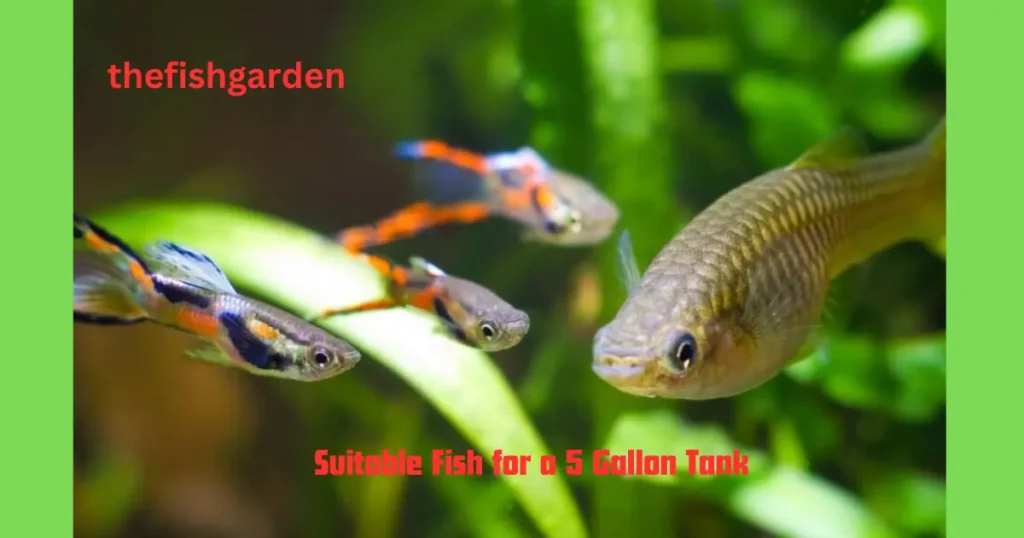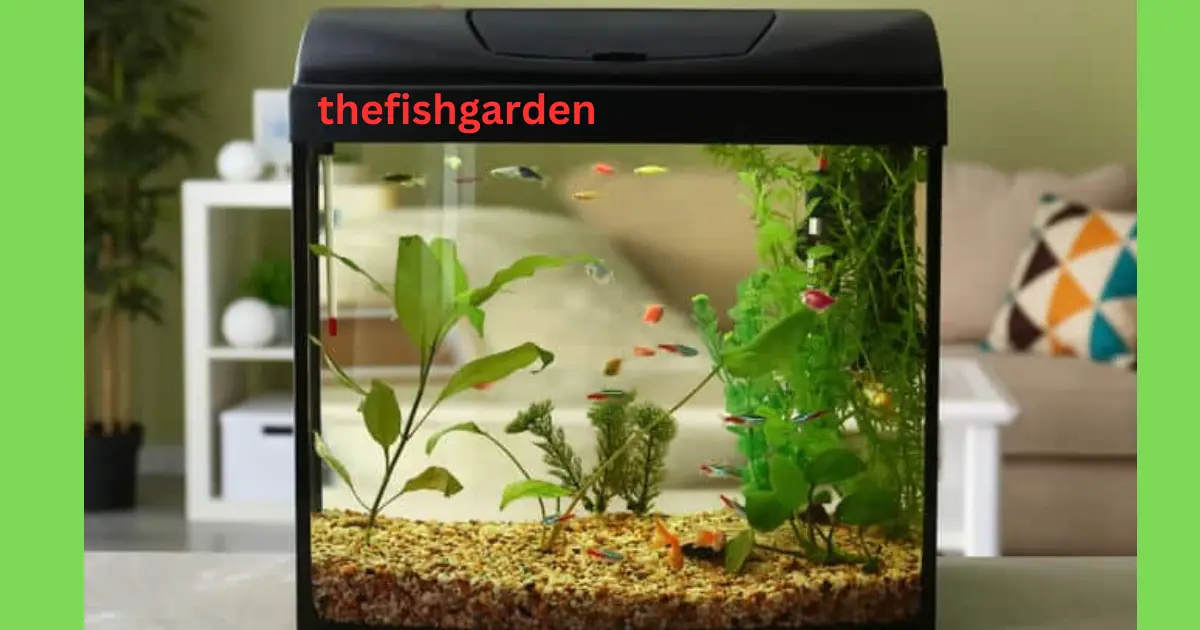A 5 gallon fish tank may seem small, but with proper planning and fish selection, it can comfortably house a good variety of fish. The key factors in determining stocking capacity are:
- Filtration capacity
- Swimming space
- Species compatibility
- Tank maintenance
Follow the guidelines below to learn how to successfully keep fish in a 5 gallon tank.
What is Considered Overstocking a 5 Gallon Tank?
Overstocking a tank occurs when you add more fish than the tank can handle. This causes water quality issues and stresses the fish. As a general rule, a 5 gallon tank should house 1 inch of fish per 1 gallon of water.
So what is considered overstocking for a 5 gallon tank? Here are some examples:
- 6 neon tetras (each around 1.5 inches)
- 1 betta (around 2.5 inches) plus 5 harlequin rasboras (around 1.25 inches each)
- 2 dwarf gouramis (each around 2 inches)
- 1 pearl gourami (around 3 inches)
- 3 male guppies (each around 1.5 inches)
These combinations would exceed the recommended 5 inch total length of fish for a 5 gallon tank. Avoid overstocking by sticking to the 1 inch per gallon rule.
What is the Maximum Number of Fish for a 5 Gallon Tank?
Based on the 1 Inch per Gallon Rule
As mentioned above, the standard 1 inch of fish per 1 gallon of water allows for around 5 inches of fish in a 5 gallon tank.
Here are some appropriate stocking options:
- 1 betta (around 2.5 inches)
- 5 neon tetras (each around 1.5 inches)
- 1 dwarf gourami (around 2 inches) plus 2 pygmy cories (each 1 inch)
- 1 honey gourami (2 inches) plus 5 small rasboras (each 1 inch)
So realistically, the maximum is 5 small fish or 1 centerpiece fish plus a few smaller companions. Exceeding this risks poor water quality and stress.
Other Considerations
It’s also important to factor in:
- Behavior – Aggressive or active fish need more room.
- Bioload – The waste fish produce should fit filtration capacity.
- Swimming space – Fish should have room to move comfortably.
These considerations may lower the maximum fish count further than the 1 inch guide. Prioritize quality of life over quantity when stocking a 5 gallon tank.
Table 1: Maximum Recommended Fish Counts for a 5 Gallon Tank
| Fish Size | Max Number | Combination Examples |
|---|---|---|
| Under 1 inch | 5 | Neon tetras, guppies |
| 1-2 inches | 3 | Endlers, rasboras |
| 2-3 inches | 2 | Dwarf gouramis, betta + snails/shrimp |
| Over 3 inches | 1 | Single betta or a single dwarf gourami |
Suitable Fish for a 5 Gallon Tank

Many fish thrive in 5 gallon tanks when properly cared for. Here are some top options:
Betta Fish
- Max of 1 per 5 gallon
- Peaceful, low bioload
- Entertaining behaviors like bubble nests
- Males must be kept alone
Small Tetras
- Max of 5-6 in a school
- Neon, ember, glowlight tetras recommended
- Active and peaceful, need swimming space
Rasboras
- Keep 6-8 in a school
- Chili, Phoenix, pygmy rasboras work well
- Fun to watch schooling behaviors
Guppies
- Max of 3, keep either males or females
- Very active, may nip fins of slow tankmates
- Breed readily, provide females hiding spots
Dwarf Corydoras Catfish
- Max of 5-6 pygmy or habrosus cories
- Peaceful bottom dwellers, need sand substrate
- Social, fun to watch schooling and foraging
Snails and Shrimp
- Great clean up crew for extra bioload
- 1-2 nerite snails or 5-10 cherry shrimp
- Peaceful, raise water quality and activity
Ideal Tank Conditions for a 5 Gallon
Creating the right water conditions is key to fish health in small tanks. Here are the optimal parameters to provide:
- Temperature: 72-82°F depending on species. Bettas need 78-80°F.
- pH: Ideal range is 6.5-7.5. Lower side for tetras and rasboras, higher for livebearers.
- Water hardness: Soft to moderately hard or 5-10 KH. Use RO water or peat to soften if needed.
- Filtration: Gentle but effective like a sponge filter. Avoid strong currents.
- Heating: Steady heater rated for 5-15 gallons. Keep temperature stable.
- Lighting: Low to moderate intensity LED lighting. 6-8 hours per day.
- Plants: Several live plants like java fern, anubias, moss balls to absorb waste.
- Decor: Rocks, driftwood, caves. Layer substrate if having bottom dwellers.
With the right setup tailored to your fish, a 5 gallon tank can be a thriving ecosystem.
5 Gallon Stocking Ideas
Here are some great options for stocking a 5 gallon tank while avoiding overcrowding:
1. Planted Betta Tank
- 1 male betta
- Several marimo moss balls
- 5 red cherry shrimp
2. Tetra Nano School
- 6 ember tetras
- 5 pygmy cory cats
- 2 nerite snails
3. Rasbora Gang
- 6 chili rasboras
- 5 habrosus cories
- 1 mystery snail
4. Guppy Trio
- 3 male guppies
- 5 ghost shrimp
- Java fern, java moss
5. Dwarf Gourami Showcase
- 1 powder blue dwarf gourami
- 5 pygmy cories
- Anubias, cryptocoryne plants
Tank Maintenance for 5 Gallons
Frequent water changes are crucial for managing waste in small tanks. Follow this schedule:
- Weekly – 25-30% water change, vacuum gravel, wipe glass
- Monthly – Check filter media, replace as needed
- Every 2-3 months – Deep clean hardscape decor
Test water parameters 1-2 times per month and adjust as needed. Provide a variety of foods in small portions 2-3 times daily.
Observe fish closely and look for signs of stress like clamped fins, gasping, color change. React quickly to issues to keep water clean and fish healthy.
Setting Up a New 5 Gallon Tank Step-by-Step
Follow these steps to safely set up a new 5 gallon tank:
1. Wash the Tank
Disinfect inside with light bleach solution. Rinse thoroughly and let dry fully. Attach filter and heater.
2. Add Substrate
1-2 inches of fine gravel or sand. Slope gently upwards in back.
3. Decorate and Plant
Add cleaned rocks, driftwood and artificial plants. Layer real plants in back, midground and foreground sections.
4. Fill Slowly with Treated Water
Fill tank no more than halfway and add dechlorinator. Let sit 1 day and check for leaks.
5. Install Heater and Filter
Get water flow established and set heater to desired temperature. Let run overnight.
6. Adjust to Ideal Water Parameters
Test for pH, hardness and temperature. Do partial water changes as needed.
7. Cycle Tank without Fish
Add ammonia daily, test until bacteria establish and process ammonia/nitrites. Takes 4-8 weeks.
8. Acclimate Fish and Begin Stocking
Turn off lights and float bags for 30 mins. Release fish gently. Avoid overstocking.
9. Maintain Proper Tank Conditions
Keep up with weekly water changes, filter cleaning and water testing. Remove waste promptly.
5 Gallon Tank FAQ
1. Can I put a betta and a few neon tetras in a 5 gallon tank?
This combination would overload the tank. Neon tetras need to be in schools of 6+ and require more swimming space than a 5 gallon allows. Stick to just 1 betta in a 5 gallon.
2. What cleaning should I do for a 5 gallon tank?
- Weekly 25-30% water changes, gravel vacuuming, glass wiping
- Monthly filter media rinsing or replacing
- Every 2-3 months deep clean hardscape and decor
3. What fish can live with a betta in a 5 gallon?
Tankmates should be peaceful, occupy different water levels, and have low bioloads. Good options are shrimp, snails, pygmy cories, and small rasboras or tetras. Avoid fin nippers like guppies.
4. Can I divide a 5 gallon tank for multiple bettas?
It’s generally not recommended. After dividing, each section holds less than 3 gallons which is difficult to keep stable. Bettas are also stressed sensing other males so close.
5. Do I need a heater for a 5 gallon betta tank?
Yes, bettas require 78-80°F water. The small volume is prone to temperature fluctuations without a heater. Get an adjustable 50 watt heater and thermometer.
Conclusion
A 5 gallon tank may be small, but it opens up a variety of interesting stocking options beyond just a single betta. Nano schooling fish, shrimp, snails, and nano bottom dwellers can all thrive in this size tank given the right tankmates and care regimen.
The keys are to select appropriate tankmates, provide strong filtration, adhere to a strict maintenance schedule, and test water quality frequently. Observe inhabitants closely for signs of stress or aggression and be prepared to separate or rehome fish if needed. When set up thoughtfully, a 5 gallon tank can be a colorful, engaging addition to any space.
